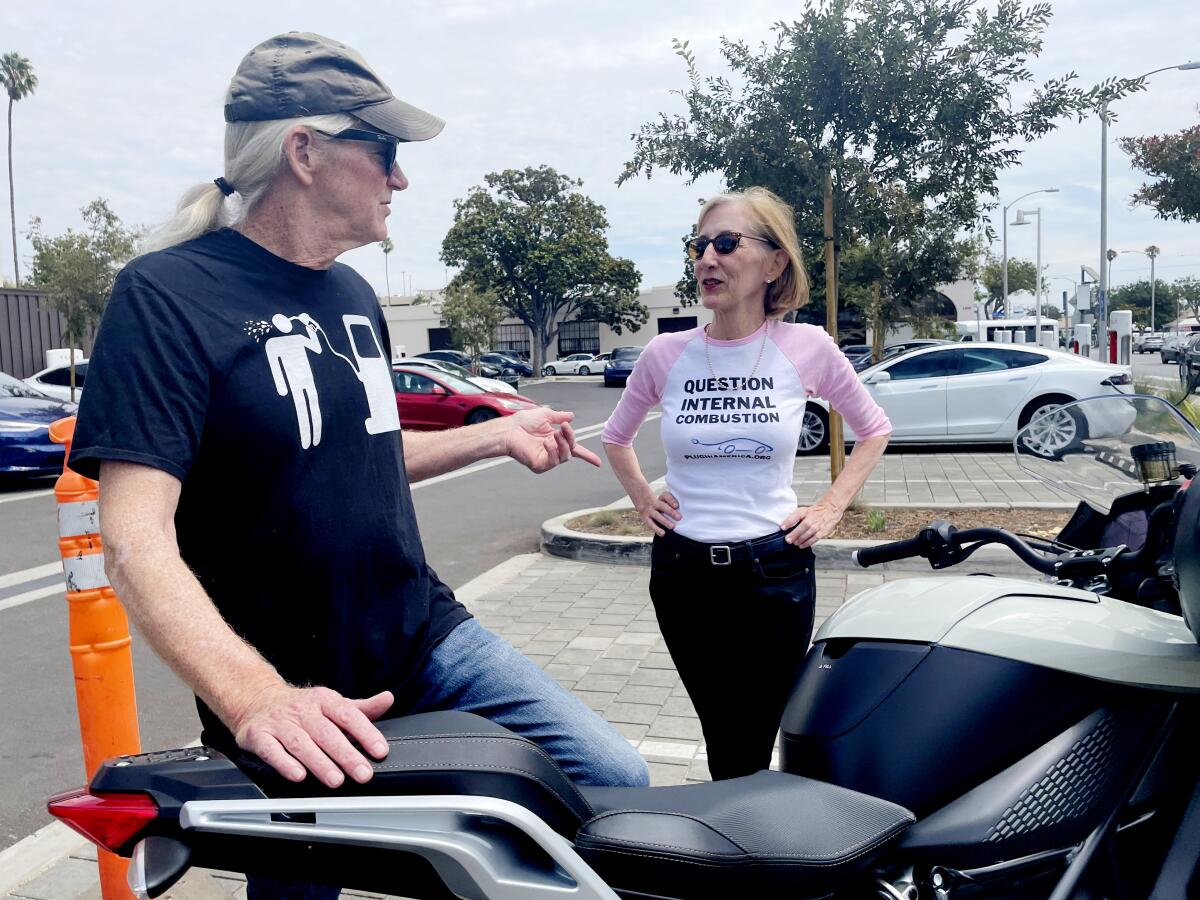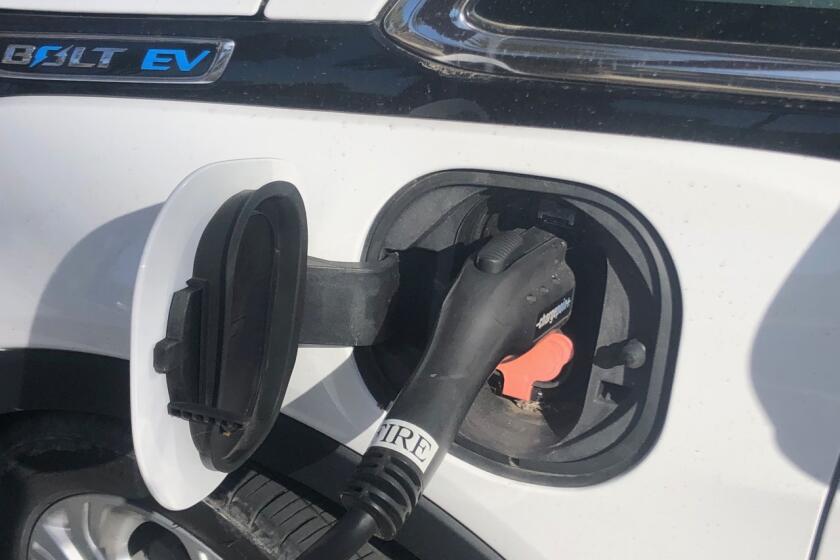Column: We’re in a climate crisis. It shouldn’t be this hard to buy an electric car

A year and a half ago, my conscience got to me, so I went shopping for an electric car.
I’d written about why Los Angeles now has more humidity and mosquitoes, why Joshua trees are dying, why juvenile great white sharks are migrating north to Monterey Bay, why there’s less coastal fog and slower growth in redwood forests, and why trophy grapes like cabernet sauvignon are living on borrowed time.
Climate change is the culprit, and vehicle emissions are a major cause.
My old Prius was no gas-guzzler, but it was beaten up and I was ready for some new wheels. I had issues, though, with the electric vehicles I considered.
They were too expensive. There weren’t enough charging stations, other than for Teslas, to make long-distance travel convenient. Battery technology was still evolving, and mining for materials created an environmental hazard.
For California consumers thinking about going electric, the Inflation Reduction Act could tilt the math in favor of nabbing that new Model 3 or F-150 Lightning sooner than later.
So instead of going all electric, I decided to wait for better options and take a half-step toward cleaner energy in the interim. I leased a plug-in hybrid.
My Kia Niro goes 24 miles on electric power, then switches to gas and gets about 45 miles to the gallon. Because so many of my trips are short, the majority of my drives are all electric, and recharging is easy. I plug the car in each evening, to a standard 110-volt outlet, and wake up to another 24 miles of electric power. And plug-in hybrids are much cheaper than all electric.
But I’m going to confess to a bit of buyer’s remorse. The evidence of accelerating climate change has become more alarming, with California as dry as dust and much of the world suffering through record heat and drought, along with the drought-deluge cycle associated with climate change.
Then there was the price of gas, which topped $6 a gallon and made me wish I’d gone all electric. On top of that, state subsidies and federal tax credits were becoming available to accelerate the conversion away from fossil fuels.
And then I opened the paper one day and read a letter to the editor by Paul Scott, co-founder of Plug In America, an electric car advocacy group.
“Never buy a gas car again, and to the extent you have influence, don’t let your friends, family, co-workers or neighbors buy one either,” wrote Scott.
One day I met with Scott and Zan Dubin-Scott at a Tesla charging station in Santa Monica. They’re divorced, but still married to a cause they embraced in earnest after Scott was diagnosed with cancer many years ago.
“He came home and said to me, ‘I want to live my dream,’” said Dubin-Scott.
Scott’s first move was to convert to solar power, and he weaned himself off of gasoline. He owns a Tesla, which he rents to an acquaintance, and owns half of another Tesla, which he shares with a friend. But for the most part, he gets around on an electric motorcycle.
“When you charge your electric vehicle on solar power, you’re driving on sunshine,” said Scott, who told me, “the burning of gasoline causes more harm than anything the average American does.”
Maybe so, but as I looked into trading in my plug-in hybrid for an all-electric vehicle, there weren’t a ton of great options out there if you’d rather not bust your budget. You can find an electric Volkswagen for just under $50,000, a BMW in the mid-50s and Audis for $60,000, $80,000 or more, but no thanks. Even used electrics are more than I’m willing to pay.
It’s such a missed opportunity because the combination of a melting planet and high gas prices are driving demand, but pandemic supply chain problems have meant low supply and high prices.
Dubin-Scott, who drives a Chevy Volt — a plug-in hybrid that goes twice as far as mine on electric power — said there’s an argument for holding on to my car a while longer. Given the battery production issues, she said, it’s worth noting that several plug-in hybrids can be powered by the same amount of material it takes to power one all-electric vehicle.
She referred me to two people — Chelsea Sexton, an automobile industry analyst and EV advocate, and David Eagle, an independent EV broker.
“I do think you should keep your car,” Sexton told me. She added that research indicates there’d be a bigger market for plug-in hybrids if they had a 60-mile all-electric range, so maybe those options will be available in years to come.
As for Eagle, who started a company called Current EV several years ago, business built gradually, and then came the pandemic.
“When the Ukraine war broke out and gas prices started going up, our business quadrupled overnight” in terms of the number of clients trying to land EVs, Eagle said. “But there are nowhere near enough vehicles for them to buy or lease, and when there are, they’re being marked up like crazy — some by 20K or more.”
One exception, Eagle said, is the new Chevy Bolt EV (starting at $26,000) and the larger Bolt EUV. Clients are making deposits and waiting two or three months for delivery, he said.
“We just did a deal for a client that got a total of $5,000 in discounts,” he said, not including “the $7,500 tax credit or $2,000 clean-air vehicle rebate.”
If I want more options and lower prices, Eagle said, it might be best to hold on to my Kia until the lease runs out in 18 months.
By then, maybe some of the kinks in government incentives will be worked out. As it is, the federal tax credit of up to $7,500 for EVs in President Biden’s new climate, tax and health law is a confusing mishmash. It covers vehicles manufactured in North America, but excludes foreign models including Kia and Hyundai, both of which are producing cars I’m interested in.
What will the Inflation Reduction Act do for you?
I understand the realities of legislative compromise, but come on. We’re at a tipping point, and compromising on climate change initiatives makes for small steps forward when giant leaps are needed.
In California, where Gov. Gavin Newsom has set a goal of banning the sale of gas-powered vehicles by 2035, the charging infrastructure is in place for expensive Teslas, but not for cheaper electric cars. And the disappointing reality is that EV incentive programs for low- and moderate-income buyers either have long waiting lists or have been shut down, as CalMatters laid out this month.
Supply shortages are largely to blame, said Tim Tyner, co-director of the Central California Asthma Collaborative. The agency, which advocates for cleaner air and works with the state on EV incentives, has drawn interest from several thousand residents but has managed to line up only 23 clients with electric vehicles in recent months due to supply shortages and state funding limitations.
For some clients, Tyner said, several thousand dollars in financial incentives were negated by dealer markups, putting new cars beyond reach.
“Awareness is there and interest is there,” Tyner told me. “But unfortunately, I think we are at least a year or two years behind where we want to be in terms of having vehicle pricing and incentives all line up.”
For the time being, I’ll hold on to my plug-in hybrid.
But like I said, we’re in a state of emergency that screams out for us to pick up the pace.
More to Read
Sign up for Essential California
The most important California stories and recommendations in your inbox every morning.
You may occasionally receive promotional content from the Los Angeles Times.













